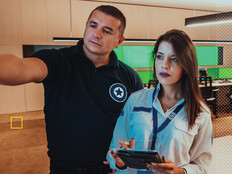Centralized Management
The NComputing L300 kit easily connects monitors to a host over Ethernet.
Desktop virtualization in the enterprise often requires an army of IT professionals and a hefty price tag. But with the NComputing L300 Ethernet virtual desktop kit, you can have a virtual desktop infrastructure up and running in less than 15 minutes.
End-User Advantages
With virtual desktops, each user expects a rich and unique experience, including well-performing applications and access to Internet and video.
The L300 delivers such an experience. We tested the device using an underpowered Windows XP notebook as the host, with two L300 devices remotely connected. Primary office applications such as e-mail and word processing ran fine. We clicked through some websites and found that even with our underpowered host, most streaming media and Adobe Flash applications performed well.
Without any moving parts, the 4.5-inch square L300 device is noiseless and can attach to the back of a monitor. It features USB mouse and keyboard connections, a speaker and microphone, and two additional USB 2.0 ports. The VGA port supports up to 1600x1200 (standard) and 1920x1080 (widescreen) pixel resolutions at 16- or 24-bit color with a 60-hertz refresh rate -- just like any other video card -- and the device consumes only 5 watts of power.
Why It Works for IT
Each kit comes with an NComputing L300 virtual desktop device and vSpace desktop virtualization software. You simply add one Windows XP/2003 host, a USB keyboard and mouse, a monitor and an Ethernet connection. Because the solution works over a 10/100 megabit-per-second network, there is no restriction on distance between the L300 device and the host computer, although they should be on the same LAN for best performance. The kit includes a bracket for mounting the L300 device to the back of an LCD monitor.
Installation of vSpace is very straightforward. The software prompts you to download the latest version from NComputing, several virtual drivers are installed, and then you're on your way. The L300 automatically scans the subnet for available hosts, and connects with just a click.
No special training or modification of your applications is necessary. The vSpace software takes care of the multiÂsessions, and users' preferences and settings are stored in their own user directories on the PC.
With a properly outfitted 32-bit host, you can connect up to 30 L300 devices. Imagine how easy it would be to apply software patches to just one host instead of 30 PCs.
Disadvantages
As you might expect from sharing a single host, the L300 isn't for every application. It's not recommended for 3D-intensive applications such as computer-aided design or movie-Âediting software. We had some trouble with high-quality, high-definition videos, but remember, we were on an underpowered system. Power users may notice a performance slowdown if they're sharing a host with others who also do heavy number crunching or other processor-intensive tasks. But for most office workers, this shouldn't be a problem.








